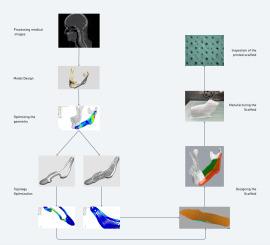设计患者专用下颌骨重建板和混合支架
IF 7
2区 医学
Q1 BIOLOGY
引用次数: 0
摘要
背景:尽管下颌骨重建板、有限元方法、计算机辅助设计和制造技术以及新型手术方法取得了显著进展,但处理下颌骨节段性缺损仍具有挑战性,需要采用多学科方法。复杂的手术需要采用综合方法,因为仅使用重建板或组织支架可能无法达到最佳效果。应研究治疗方案的局限性,并根据患者的具体情况进行调整,以缩短手术时间、改善愈合效果并降低成本。综合混合支架系统在改善机械性能和促进愈合方面大有可为。通过结合不同的材料和结构,混合支架可为组织再生过程提供更强的支撑力和稳定性,从而为患者带来更好的治疗效果。材料与方法:使用一名牙源性肌瘤患者的头颈部计算机断层扫描(CT)数据创建三维(3D)下颌骨模型。进行虚拟截骨以创建节段性缺损模型,包括下颌角区域。设计了第一块下颌骨重建板。通过有限元分析(FEA)和拓扑优化,为不同的治疗方案创建了两种不同的重建板。对这两种重建板进行有限元分析,以评估其生物力学性能。为了提供骨传导和骨诱导特性,利用缺损区域设计了一个支架。结果:硅内分析结果表明,所设计的重建板具有稳健的生物力学性能,在最剧烈的咀嚼活动中也表现出显著的稳定性。使用 Voronoi 模式可在不损失耐力的情况下将质量减少 37%。重建板和混合支架的临床应用前景广阔,有待进一步的体内和临床研究。本文章由计算机程序翻译,如有差异,请以英文原文为准。

Design of patient-specific mandibular reconstruction plates and a hybrid scaffold
Background:
Managing segmental mandibular defects remains challenging, requiring a multidisciplinary approach despite the remarkable progress in mandibular reconstruction plates, finite element methods, computer-aided design and manufacturing techniques, and novel surgical procedures. Complex surgeries require a comprehensive approach, as using only reconstruction plates or tissue scaffolds may not be adequate for optimal results. The limitations of the treatment options should be investigated towards a patient-specific trend to provide shorter surgery time, better healing, and lower costs. Integrated hybrid scaffold systems are promising in improving mechanical properties and facilitating healing. By combining different materials and structures, hybrid scaffolds can provide enhanced support and stability to the tissue regeneration process, leading to better patient outcomes. The use of such systems represents a significant advancement in tissue engineering and a wide range of medical procedures.
Materials and Methods:
A head and neck computed tomography (CT) data of a patient with odontogenic myxoma was used for creating a three-dimensional (3D) mandible model. Virtual osteotomies were performed to create a segmental defect model, including the angulus mandibulae region. The first mandibular reconstruction plate was designed. Finite elemental analyses (FEA) and topology optimizations were performed to create two different reconstruction plates for different treatment scenarios. The FEA were performed for the resulting two plates to assess their biomechanical performance. To provide osteoconductive and osteoinductive properties a scaffold was designed using the defect area. A biomimetic Tricalcium phosphate-Polycaprolactone (TCP-PCL) hybrid bone scaffold enhanced with Hyaluronic acid dipping was manufactured.
Results:
The results of the in-silico analysis indicate that the designed reconstruction plates possess robust biomechanical performance and demonstrate remarkable stability under the most rigorous masticatory activities. Using the Voronoi pattern decreased the mass by %37 without losing endurance. Using reconstruction plates and hybrid scaffolds exhibits promising potential for clinical applications, subject to further in vivo and clinical studies.
求助全文
通过发布文献求助,成功后即可免费获取论文全文。
去求助
来源期刊

Computers in biology and medicine
工程技术-工程:生物医学
CiteScore
11.70
自引率
10.40%
发文量
1086
审稿时长
74 days
期刊介绍:
Computers in Biology and Medicine is an international forum for sharing groundbreaking advancements in the use of computers in bioscience and medicine. This journal serves as a medium for communicating essential research, instruction, ideas, and information regarding the rapidly evolving field of computer applications in these domains. By encouraging the exchange of knowledge, we aim to facilitate progress and innovation in the utilization of computers in biology and medicine.
 求助内容:
求助内容: 应助结果提醒方式:
应助结果提醒方式:


